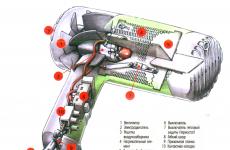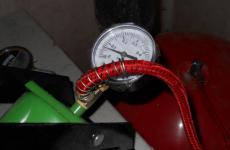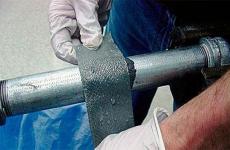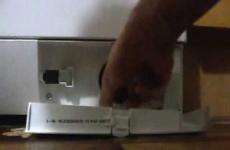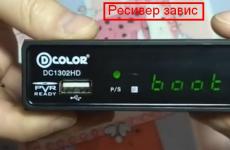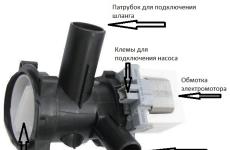TV antennas for DVB-T2, a selection of recommended antennas
TV antenna - when there is a need to make a choice, many find it difficult to buy an antenna to receive free digital television. For this reason, many are bought for advertising gimmicks and there is a high probability of purchasing an unimportant antenna for a lot of money.
Hello dear readers! The author of this blog, Vitaly, is in touch! In my previous article on this topic, I talked about the antenna known as "The Key to Digital TV" And the readers of this post very often ask the question about which antenna to choose?
To answer most of these questions at once, it was decided to write another article in which there will be a selection of antennas recommended by me and other specialists. And also some explanations and recommendations. Please read them carefully, perhaps this will clear some of your questions.
P.S. The article lists the names of the antennas, but note that they may differ from manufacturer to manufacturer. This means that antennas of a similar type and characteristics can have the name LOCUS, DELTA, MERIDIAN, ETHIR, etc. Therefore, it is not necessary to be guided by the given names, look at the appearance!
All images in the article will be numbered, but this is only so that I could easily indicate the recommended antennas, if asked about it later. There is no rating in this numbering! For convenience only. So! Go!
Fast navigation through the article
Indoor antennas

Indoor antenna Sirius 2.0 without amplifier. Designed for use in areas with a strong signal. These are settlements in which there are transmitting towers and at a short distance from them, 5-15 km. With line of sight. Signal gain 5 dB. Such antennas can be performed with an amplifier, but this does not make them suitable for difficult signal reception conditions.
Indoor antenna with amplifier DVS-Z2. Although this antenna has a large gain, up to 32 dB (due to the amplifier), there will be little sense from it. I also recommend using it in areas of reliable reception and at short distances from the tower of 5-15 km. With line of sight. It is good to use such an antenna in a city to receive a reflected signal, an amplifier can be useful in this. And it is powered through an antenna plug with a voltage of 5 volts.
The next group of indoor antennas
They have approximately the same characteristics. These are passive (no amplifier) antennas. Signal amplification factor 4-7 dB. But they will be somewhat more efficient than the antennas provided above.

These are not bad antennas, they can be successfully used to receive digital television in areas of both a strong signal and at some distance from TV towers. For example, I receive a signal with antennas of this kind from a distance of about 20 km. and from the first floor, but not everyone is so lucky!
It all depends on many factors. Transmitter power, terrain, clutter with high-rise buildings .... In general, if there is nothing very close on the way from you to the TV tower, then these antennas may well cope.
Indoor antennas with amplifier
These antennas do about the same as those without an amplifier. But the amplifier is useful in some cases and helps to pull the attenuated signal to an acceptable level. They can be used not only in areas of a good signal, but also, let's say, a slightly complicated or reflected signal.
But still, these are indoor antennas and this limits them. For example, if your windows do not face the TV tower, and there is no way to catch the reflected signal from the opposite side, they may be useless.
By the way! There is no need not to evaluate the reflected signal, you can perfectly watch digital television on it.

Locus L999.06 Next - Active broadband antenna. Supplied unassembled. The amplifier is powered by 12 volts from an external power supply. The UHF gain is 23-27 dB.
Locus L922.06 Not a bad indoor antenna. Looks neat, there are options with and without an amplifier. The amplifier version is equipped with a power regulator, which can be very useful.
Delta K131A.02 and the other two from the above group are also active antennas, but with a 5 Volt amplifier supply voltage. It can be fed directly from the DVB-T2 set-top box or through a special injector from the USB port of the LCD TV. The gain of these antennas is up to 22-27 dB.
Cayman active antenna , - can be in two versions 1) Powered through the antenna plug. 2) With a built-in injector for power supply from the USB port, which is very convenient for use with LCD TVs that have this port. There is no need to purchase an additional 5-volt power supply unit with an injector and take up another outlet.
Outdoor antennas for digital television
Moving on to more serious designs, the task of which is to provide a high-quality signal where indoor antennas cannot cope. Gain from 19 dB to 35 dB.
These are antennas that can be used in more difficult conditions and at somewhat longer distances. If you have noticed, they are structurally similar to indoor antennas, but only slightly larger. And this is the important factor that makes them more powerful. The longer the boom in the antenna, the greater the coefficient of its own gain. This is the gain that is achieved not due to the amplifier, but due to the design of the antenna. And the installed amplifier only "shakes" this signal even more.
In addition, the outdoor installation allows them to more accurately direct them to the TV tower, bypassing obstacles in the form of walls.
Hummingbird - An interesting antenna. Works both in the meter and dmv ranges. Its peculiarity is an unusual design, which, despite its small dimensions, provides a fairly good signal reception. It is very convenient in urban conditions and for finding the reflected signal, the short length allows it to be installed in a confined space. It has several modifications and can be supplied with an amplifier powered by either 12 or 5 volts.
Locus -14 AF - This antenna also has several modifications, designation AF- with amplifier, F - without amplifier. There is also Locus - 20 AF / F is distinguished by a longer boom, and therefore an even greater coefficient of its own amplification. The amplifier operates on 5 volts.
Delta H3111.02 - There are also options with and without an amplifier, in addition, it may be under a different name (depending on the manufacturer) and differ in the method of connecting a television cable to it.
Meridian - 07 AF — Made of aluminum.
Antennas numbered 11-14 These are good antennas and affordable, only "Kolibri" will be somewhat more expensive
They can be used at a distance of up to 30 km. But again, if there are factors that interfere with the passage of the signal, then even at closer distances an even more powerful antenna may be needed.
Powerful antenna for digital TV
These antennas are good for long distances and even more difficult conditions, for example, if your house is in a strong lowland.
At what long distances can they be used? For example, I had to put Ether 18AF (by the way, not the strongest in this trio) on a house located 45 kilometers from the TV tower. The house stood at the same time in the lowland, and the antenna was fixed on the ridge of the roof of the house, there was some kind of pin sticking out, and the antenna was fixed on it. Everything is great!

Ether 18 - Antenna made of steel, powder coated, available with and without amplifier. The letter A in the name indicates that the antenna is active, with an amplifier. If there is only F in the name, then this is an antenna without an amplifier. Meridian -12 AF / F antennas are also marked.
Meridian-12 and Triton - Made of aluminum and even more powerful than Ether-18. The reason is not only in the material, but also in the design. For example, the antenna "Meridian" is about 1.5 meters long. And "Triton" has short arrows, but there are already three of them. It adds up to one long.
Active antennas from this trio have amplifiers powered by 5 volts. Which is convenient for use with DVB-T2 set-top boxes. The Triton antenna also has an injector for power supply via USB, which is indicated in the marking. The gain of these antennas reaches 35 dB. due to the amplifier. But thanks to their design, the amplifier has something to strengthen)))
THOSE. the antenna itself pulls a signal from the air with a level of about 10-12 dB (this is called the antenna's own gain), and the amplifier already accelerates it to 35 dB.
The most powerful antenna for DVB-T2
Well, if you carefully read the previous descriptions, then you should understand why these antennas are the most powerful ones presented in this review.

For example, the GoldMaster-GM500 antenna is a passive antenna, without an amplifier. But the coefficient of its own gain, only due to the design as much as 22 dB. Such gain is provided by mid-link antennas and then at the expense of the amplifier. And here in its pure form!
The next antennas from this "red zone" are just as effective, plus they are also active. Their amplifiers are powered by 5 volts. Ie are sharpened for digital set-top boxes. Or, if you do not use a set-top box, since you bought a TV set with DVB-T2, then you will need either a separate power supply unit for antennas, 5 volts, or an injector for power supply from USB.
This is the class of antennas that you need to take if you live at a distance from the transmitting tower from 50 km and further and have a very difficult area for receiving a TV signal.
Why you do not need to strive for an antenna with an amplifier
It is noticed that the word "Amplifier" has some kind of magical property! And when a person chooses an antenna, he prefers just such active antennas. Why is this a wrong point of view?
- In the zone of reliable reception, the amplifier can lead to the fact that your TV / set-top box will not receive anything at all! Reason, signal over-amplification!
- The amplifier amplifies not only the useful signal, but also the radio noise. And it is the antenna design that draws the useful signal!
- The amplifier is always the weak link in the antenna design. It breaks down, a thunderstorm hits it, it oxidizes from moisture. As a result, periodic intervention in antenna repair is required.
- It is required to provide power to the amplifier located in the antenna, and this is another additional weak link, the adapters fail and require replacement. In addition, one more connection point is required, an outlet or a USB port, and this is not always convenient!
- In the case of a connection, this is much easier to do with an antenna that does not have an amplifier.
When you need an amplifier
- If the total length of the television cable exceeds several tens of meters.
- If you live at a great distance from the transmitting tower, in an area of weak signal and the design of the antenna itself does not allow you to “pull out” the signal to the required level.
Conclusion! - If in your place of residence it is possible to confidently receive a signal to an antenna without an amplifier, always strive for an antenna without an amplifier!
How to supply power to an active antenna amplifier
There are several ways to supply power to the antenna booster.
- If you use a digital set-top box, then the power is supplied directly from it, via the antenna cable. There is no need to be smart. Just go to the set-top box menu and find the item "Power ant. on »In different models of prefixes this inscription may differ, but the essence is the same. Turn on the power to the antenna! Even if the amplifier in the antenna is 12 volts, often 5 volts from the set-top box will be enough.
- If you do not use a set-top box, then to power the active antenna you will need either a special adapter with an injector that can be connected to the USB port of the TV and so to power the antenna. Alternatively, purchase a USB powered antenna. These methods are very convenient for LCD TVs, especially those hanging on the wall.
- The classic way is through a power supply for antennas with a voltage corresponding to the amplifier.
Well, I’ll probably end on this! In the "Television" section of this blog, there are many more articles on antennas, set-top boxes, and television.

